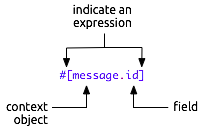A flexible tool, you can use Mule Expression Language (MEL) to evaluate many kinds of expressions, including constants, simple operands, operations with multiple values, or method calls on objects. You can also use MEL to perform regex or XPath3 functions. Thus, though the syntax is consistent, the expressions you write or come across in Mule applications may take many different forms, depending on their purpose. This document aims to offer insight into the basic syntax rules for MEL so you can write, or parse the functionality of MEL expressions.







